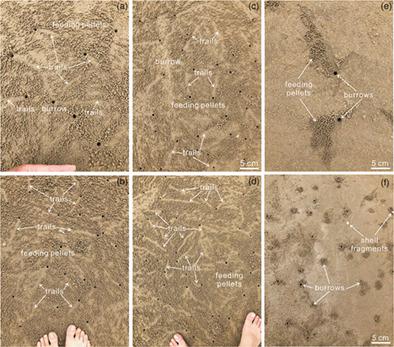当前位置:
X-MOL 学术
›
Geolog. J.
›
论文详情
Our official English website, www.x-mol.net, welcomes your feedback! (Note: you will need to create a separate account there.)
Locomotion and feeding trails produced by crabs
Geological Journal ( IF 1.8 ) Pub Date : 2021-06-01 , DOI: 10.1002/gj.4190 Zhongwu Lan 1, 2, 3 , Shujing Zhang 1, 4 , Zhong‐Qiang Chen 5 , Ross N. Mitchell 1
Geological Journal ( IF 1.8 ) Pub Date : 2021-06-01 , DOI: 10.1002/gj.4190 Zhongwu Lan 1, 2, 3 , Shujing Zhang 1, 4 , Zhong‐Qiang Chen 5 , Ross N. Mitchell 1
Affiliation

|
Trace fossils represent the biological activity of an organism in the form of trails, tracks, burrows, and borings in the geological record. Bilobate trails are known to be made by arthropod trilobites since the Early Palaeozoic. This study enhances the present state of knowledge regarding bilobate trails by demonstrating that they can also be produced by crabs reflecting different behavioural traits such as different feeding and locomotion strategies. This present-day study thus warns caution to be taken when linking horizontal trails such as Archaeonassa and Diplopodichnus with tracemakers in Jurassic strata and onwards since crabs have existed. Identifying crab-related trace fossils might be particularly insightful for understanding the earliest evolution of Jurassic crabs for which dorsal carapaces are dominantly the only form of preservation.
中文翻译:

螃蟹产生的运动和觅食轨迹
痕迹化石在地质记录中以痕迹、轨迹、洞穴和钻孔的形式代表生物体的生物活动。众所周知,自古生代早期以来,节肢动物的三叶虫就形成了双叶形痕迹。这项研究通过证明它们也可以由反映不同行为特征(例如不同的进食和运动策略)的螃蟹产生,从而增强了关于双叶形踪迹的当前知识状态。因此,这项当今的研究警告在连接诸如古龙属和双足龙等水平轨迹时要小心谨慎自从螃蟹存在以来,侏罗纪地层中的追踪器就开始了。识别与螃蟹相关的痕迹化石对于了解侏罗纪螃蟹的最早进化可能特别有见地,而侏罗纪螃蟹的背甲主要是唯一的保存形式。
更新日期:2021-06-01
中文翻译:

螃蟹产生的运动和觅食轨迹
痕迹化石在地质记录中以痕迹、轨迹、洞穴和钻孔的形式代表生物体的生物活动。众所周知,自古生代早期以来,节肢动物的三叶虫就形成了双叶形痕迹。这项研究通过证明它们也可以由反映不同行为特征(例如不同的进食和运动策略)的螃蟹产生,从而增强了关于双叶形踪迹的当前知识状态。因此,这项当今的研究警告在连接诸如古龙属和双足龙等水平轨迹时要小心谨慎自从螃蟹存在以来,侏罗纪地层中的追踪器就开始了。识别与螃蟹相关的痕迹化石对于了解侏罗纪螃蟹的最早进化可能特别有见地,而侏罗纪螃蟹的背甲主要是唯一的保存形式。



























 京公网安备 11010802027423号
京公网安备 11010802027423号